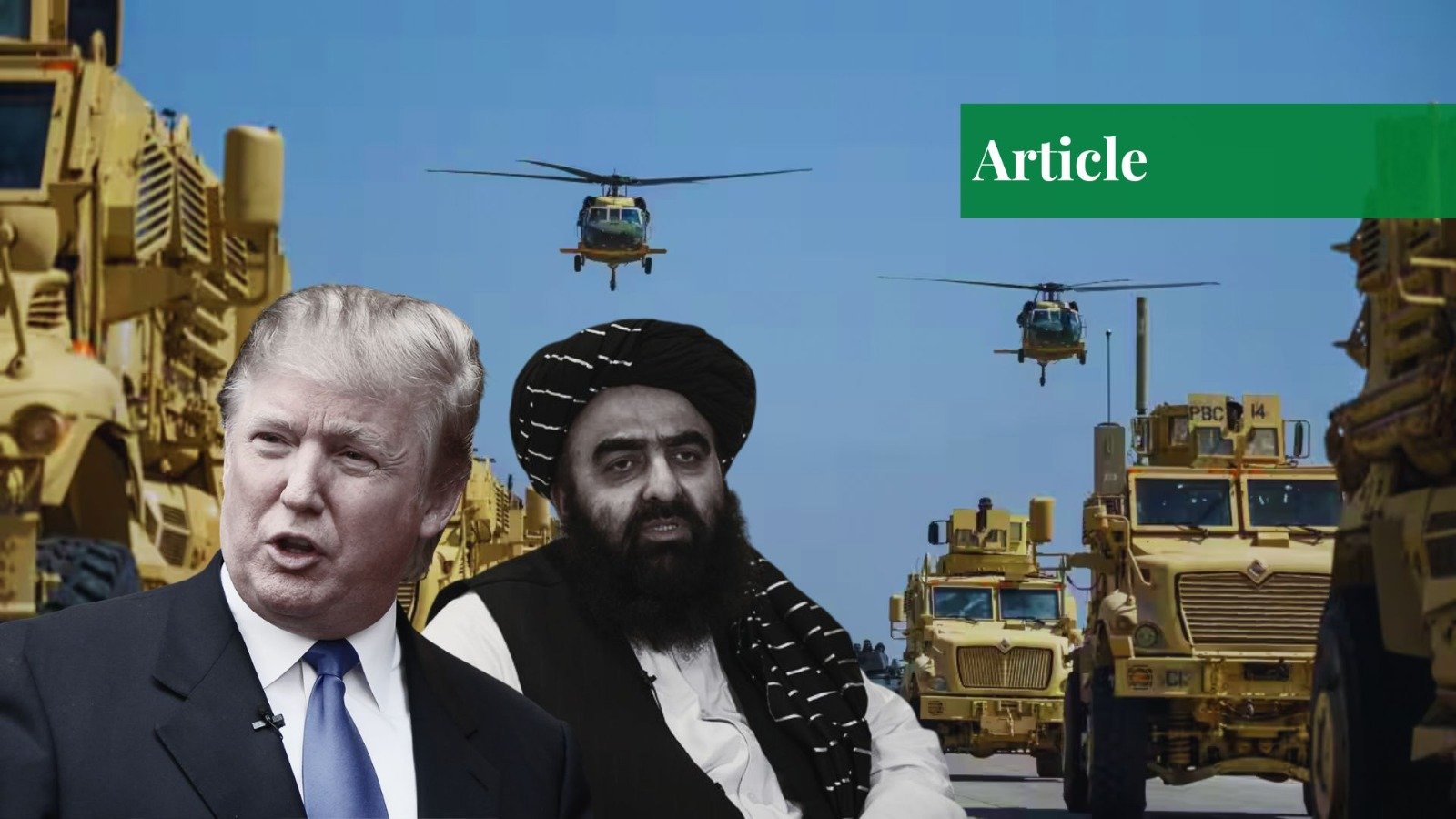The US-Afghanistan relations have been skeptical throughout the course of history. On one side, the great power rivalry, i.e. Russian invasion of Afghanistan in 1979, while on the other side, the September 11, 2001, militant attack in the US, have been the primary causes of intense rivalry between Afghan factions and the United States. The post-2001 era witnessed intense military operations inside Afghanistan, which affected the overall security situation of the region. However, President Trump concluded a peace deal with the Taliban during his first tenure in February 2020.
Later on, the Biden Administration, in August 2021, completely withdrew its forces from Afghanistan, leaving behind a stack of American weapons, artillery, and a lacuna for civil war. Since then, the US boots have not been seen on Afghan soil. However, the Trump 2.0 administration has recently signaled the US military’s hold on Bagram, Afghanistan. This article will delve into the current US strategy towards Afghanistan and its regional implications.
Historical Overview
Bagram is not just any military post. It was built by the Soviet Union in the 1950s when both Moscow and Washington, DC, were competing for influence in Afghanistan. During the Soviet-Afghan War in the 1980s, it was the Soviets’ main stronghold. After that withdrawal in 1989, the base was abandoned. But soon it became the frontline battleground between the Taliban and the Northern Alliance in the 1990s.
After the September 2001 attacks, the United States and its coalition forces seized Bagram and transformed it into their largest base in Afghanistan. Over the next 20 years, it grew into a sprawling, self-contained city. Bagram was the epicenter of the war on terror. Intelligence gathering, drone operations, and combat missions across Afghanistan and beyond were all launched from here. But in 2021, when the US forces fully withdrew, Bagram was vacated in July and then fell into the hands of the Taliban in August.
Bagram Air Base
It contains two runways (12000 ft.) capable of sustaining B-52 bombers and heavy cargo aircraft. The base accommodates over 30,000 troops and contractors with hospitals, fuel storage facilities, fast food restaurants, and even the controversial detention facility at Parwan. The following features make Bagram a strategically vital air base, especially for the US:
- The base sits at the crossroads of South Asia and Central Asia. From its runways, aircraft can reach to the west, Pakistan to the east, and even Western China and Central Asia within hours.
- Unlike smaller forward posts, the base was designed to sustain long operations. It has hardened shelters, advanced medical facilities, surveillance hubs, and housing for thousands. It could function independently like a fortress. ·
- From Bagram, the US could watch Russian moves in Central Asia, Iranian activity to the west, and China’s projects under the Belt and Road Initiative. For the US, the base is a gold mine for surveillance and signals intelligence.
Trump’s Bagram Policy
Soon after the assumption of the Oval Office in 2025, President Trump issued statements regarding the US weapons and artillery under Afghan control. According to President Trump, military equipment is the intellectual property of the United States, and it should be given back to the US. This completely aligns with Trump’s protectionist policies. But the Afghan officials explicitly declared that the US, by its choice, had left this equipment, and now it’s officially the Afghan property.
However, the recent statement by President Trump regarding the Bagram Air Base can be considered an ambiguous yet bold move to pressure the government of Afghanistan to return the equipment to the US. In an interview, Lisa Curtis, Director of the Indo-Pacific security program at the Center for a New American Security, stated, “I highly doubt that the Taliban would ever agree to allow the US troops back on Afghan soil. They didn’t fight the US and NATO forces for 20 years just to allow the US forces to return now that they are in power. The Doha agreement concluded by President Trump with the Afghan government during his first term didn’t mention any staying of the US forces at Bagram Air Base.”
Plan of Action
A Trump strategy might aim to take partial control of Bagram. Perhaps through arrangements with local commanders or Pakistan. It stops short of a full return. It takes back the base as an eavesdropping outpost. Analysts label it a low-cost means of getting back in business. Steps could be:
- Deploying engineers to repair runways and hangars.
- Establishing combined patrols with Afghans.
- Employing drones for rapid ops with minimal commitments.
Bagram can counter ISIS-K and al-Qaeda remnants. Its airfields are conducive to drone attacks and intelligence missions. Having a forward base there would facilitate quick response times. No more having to depend on far-flung places like Qatar. It aligns with Trump’s desire for swift victories against terror. Nor will it be inexpensive to return to Bagram. Hundreds of millions in repairs may be needed. Fuel, equipment, and transportation quickly rack up. Diplomats could negotiate access with the Taliban. Or rely on Pakistan for supply lines. Logistics are important as well. Overland routes from Pakistan are risky. Air drops are feasible but increase costs.
Regional and Global Implications
The policy might have repercussions all around the globe. It reaches out to old friends and new competitors. Bagram’s revival influences U.S. actions in Asia. It challenges alliances and deterrence. Negotiating with the Taliban poses challenges. Sanctions could be relaxed for base access. UN reports indicate the Afghan economy is in dire need of aid. Trump may make assistance contingent on security agreements. Results rely on the Taliban’s cooperation. Stability might increase if agreements hold. Up to this point, the Taliban has turned down Trump’s ultimatums by observing, “We assure you that giving even an inch of our land to anyone is out of the question and impossible.”
Bagram is located in Central Asia, close to China’s Belt and Road routes. An American presence prevents Beijing from expanding there. It is connected to the Indo-Pacific strategy by U.S. officials. China is already mining Afghan lithium. Recapturing the base halts it. It indicates America will not give up ground. Bagram prevents easy expansion. This energizes the competition short of confrontation. Beijing responded in crystal clear fashion. Chinese ministry states, “China respects Afghanistan’s sovereignty, independence, and territorial integrity. The destiny and future of Afghanistan ought to be in the hands of the people of Afghanistan. Inflaming tensions and engendering confrontation in the region gains no popular backing.”
Re-engagement could attract NATO allies. Some share the burden, some resist. According to the Atlantic Council, it may restore trust after 2021. Burden-sharing negotiations would accelerate. Europe could deploy advisers, not soldiers. This reinforces the alliance against shared threats. But there is still fatigue. Countries like Germany are urging less engagement. Trump’s initiative may divide opinion.
Conclusion
No doubt, once again, the US is reinventing its Indo-Pacific strategy under President Donald Trump. Trump’s Bagram Air Base Policy 2025 could restore the U.S. edge in this chaotic world. It promises better counterterrorism and checks on rivals like China, Russia, Iran, etc. However, the economic and strategic cost demands a diplomatic nexus by the US, rather than deteriorating the already fractured condition of the region.
If you want to submit your articles and/or research papers, please visit the Submissions page.
To stay updated with the latest jobs, CSS news, internships, scholarships, and current affairs articles, join our Community Forum!
The views and opinions expressed in this article/paper are the author’s own and do not necessarily reflect the editorial position of Paradigm Shift.
He is pursuing a BS in International Relations programme from International Islamic University, Islamabad and has a keen interest in research works, policy analysis, defence and strategic studies and conflict resolution.



